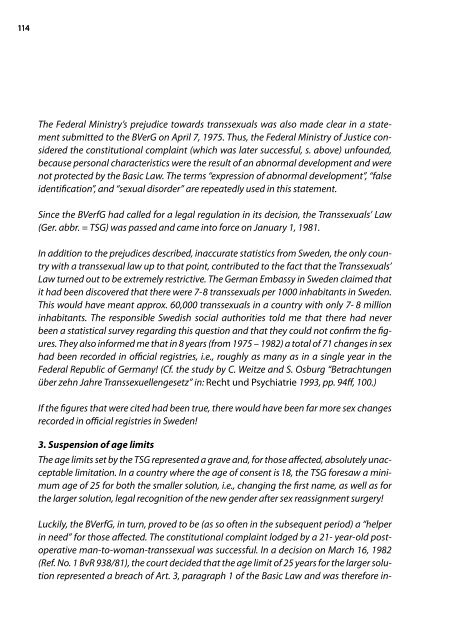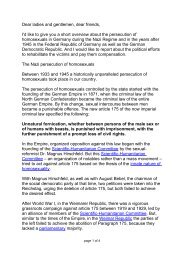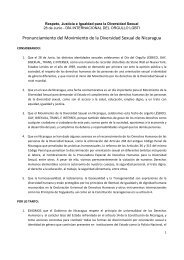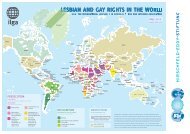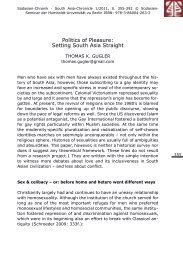Vom Verbot zur Gleichberechtigung - Hirschfeld-Eddy-Stiftung
Vom Verbot zur Gleichberechtigung - Hirschfeld-Eddy-Stiftung
Vom Verbot zur Gleichberechtigung - Hirschfeld-Eddy-Stiftung
Erfolgreiche ePaper selbst erstellen
Machen Sie aus Ihren PDF Publikationen ein blätterbares Flipbook mit unserer einzigartigen Google optimierten e-Paper Software.
114<br />
The Federal Ministry’s prejudice towards transsexuals was also made clear in a statement<br />
submitted to the BVerG on April 7, 1975. Thus, the Federal Ministry of Justice considered<br />
the constitutional complaint (which was later successful, s. above) unfounded,<br />
because personal characteristics were the result of an abnormal development and were<br />
not protected by the Basic Law. The terms “expression of abnormal development”, “false<br />
identification”, and “sexual disorder” are repeatedly used in this statement.<br />
Since the BVerfG had called for a legal regulation in its decision, the Transsexuals’ Law<br />
(Ger. abbr. = TSG) was passed and came into force on January 1, 1981.<br />
In addition to the prejudices described, inaccurate statistics from Sweden, the only country<br />
with a transsexual law up to that point, contributed to the fact that the Transsexuals’<br />
Law turned out to be extremely restrictive. The German Embassy in Sweden claimed that<br />
it had been discovered that there were 7-8 transsexuals per 1000 inhabitants in Sweden.<br />
This would have meant approx. 60,000 transsexuals in a country with only 7- 8 million<br />
inhabitants. The responsible Swedish social authorities told me that there had never<br />
been a statistical survey regarding this question and that they could not confirm the figures.<br />
They also informed me that in 8 years (from 1975 – 1982) a total of 71 changes in sex<br />
had been recorded in official registries, i.e., roughly as many as in a single year in the<br />
Federal Republic of Germany! (Cf. the study by C. Weitze and S. Osburg “Betrachtungen<br />
über zehn Jahre Transsexuellengesetz” in: Recht und Psychiatrie 1993, pp. 94ff, 100.)<br />
If the figures that were cited had been true, there would have been far more sex changes<br />
recorded in official registries in Sweden!<br />
3. Suspension of age limits<br />
The age limits set by the TSG represented a grave and, for those affected, absolutely unacceptable<br />
limitation. In a country where the age of consent is 18, the TSG foresaw a minimum<br />
age of 25 for both the smaller solution, i.e., changing the first name, as well as for<br />
the larger solution, legal recognition of the new gender after sex reassignment surgery!<br />
Luckily, the BVerfG, in turn, proved to be (as so often in the subsequent period) a “helper<br />
in need” for those affected. The constitutional complaint lodged by a 21- year-old postoperative<br />
man-to-woman-transsexual was successful. In a decision on March 16, 1982<br />
(Ref. No. 1 BvR 938/81), the court decided that the age limit of 25 years for the larger solution<br />
represented a breach of Art. 3, paragraph 1 of the Basic Law and was therefore in-


